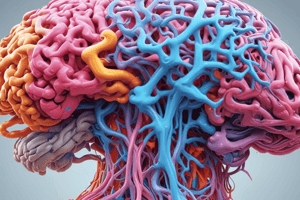Podcast
Questions and Answers
What type of tremor is most commonly associated with postural instability?
What type of tremor is most commonly associated with postural instability?
- Essential tremor (correct)
- Resting tremor
- Cerebellar tremor
- Action tremor
Which of the following conditions is NOT directly associated with hyperkinetic movements?
Which of the following conditions is NOT directly associated with hyperkinetic movements?
- Parkinsonism (correct)
- Tourette’s disorder
- Wilson's disease
- Huntington's disease
Which of the following best describes myoclonus?
Which of the following best describes myoclonus?
- Sudden lightning-like movement (correct)
- Abrupt irregular body movement
- Involuntary vocalizations
- Repetitive abnormal postures
What is a common management strategy for tics in Tourette’s disorder?
What is a common management strategy for tics in Tourette’s disorder?
Which type of dystonia might involve muscle contractions causing abnormal postures?
Which type of dystonia might involve muscle contractions causing abnormal postures?
What is the primary cause of Parkinson's disease?
What is the primary cause of Parkinson's disease?
What is the primary function of osteoblasts in bone remodeling?
What is the primary function of osteoblasts in bone remodeling?
Which condition leads to chaotic osteoclast function and increased bone remodeling?
Which condition leads to chaotic osteoclast function and increased bone remodeling?
What biological marker is notably elevated in Paget's disease and serves as a hallmark indication?
What biological marker is notably elevated in Paget's disease and serves as a hallmark indication?
What is a common consequence associated with Vitamin D deficiency?
What is a common consequence associated with Vitamin D deficiency?
Which clinical feature is most indicative of Paget's disease?
Which clinical feature is most indicative of Paget's disease?
What is the primary use of the FRAX score?
What is the primary use of the FRAX score?
Which of the following is a secondary condition that can lead to osteoporosis?
Which of the following is a secondary condition that can lead to osteoporosis?
Which of the following is NOT a result of bone remodeling?
Which of the following is NOT a result of bone remodeling?
What immediate action should be taken for a patient with absent breath sounds and hemodynamic instability suspected of tension pneumothorax?
What immediate action should be taken for a patient with absent breath sounds and hemodynamic instability suspected of tension pneumothorax?
Which of the following statements about Osgood Schlatter disease is true?
Which of the following statements about Osgood Schlatter disease is true?
Which factor is NOT indicative of a toddler's fracture?
Which factor is NOT indicative of a toddler's fracture?
What is a critical characteristic of flail segments in rib fractures?
What is a critical characteristic of flail segments in rib fractures?
What is a primary management strategy for rib fractures?
What is a primary management strategy for rib fractures?
What are the consequences of high intrathoracic pressure due to tension pneumothorax?
What are the consequences of high intrathoracic pressure due to tension pneumothorax?
What is primarily affected by the accumulation of Lewy Bodies in Parkinson's Disease?
What is primarily affected by the accumulation of Lewy Bodies in Parkinson's Disease?
Which feature is characteristic of Huntington's Disease?
Which feature is characteristic of Huntington's Disease?
What clinical sign is commonly associated with Wilson's Disease?
What clinical sign is commonly associated with Wilson's Disease?
Which physiological change results from the loss of striatal inhibitory output in Huntington's Disease?
Which physiological change results from the loss of striatal inhibitory output in Huntington's Disease?
What is a common consequence of spinal cord transection?
What is a common consequence of spinal cord transection?
What is a key characteristic of Central Cord Syndrome?
What is a key characteristic of Central Cord Syndrome?
What is often increased in a 24-hour urine test for Wilson's Disease?
What is often increased in a 24-hour urine test for Wilson's Disease?
Which of the following is a common management option for Wilson's Disease?
Which of the following is a common management option for Wilson's Disease?
What brain structure undergoes pronounced atrophy in Huntington's Disease?
What brain structure undergoes pronounced atrophy in Huntington's Disease?
What unusual psychiatric risk is associated with Huntington's Disease?
What unusual psychiatric risk is associated with Huntington's Disease?
Which condition is characterized by cerebellar tonsils and medulla herniating through the foramen magnum?
Which condition is characterized by cerebellar tonsils and medulla herniating through the foramen magnum?
Which autoimmune disorder is associated with small cell lung carcinoma and presents with bulbar symptoms?
Which autoimmune disorder is associated with small cell lung carcinoma and presents with bulbar symptoms?
What is the primary symptom of Carpal Tunnel Syndrome related to nerve compression?
What is the primary symptom of Carpal Tunnel Syndrome related to nerve compression?
Which of the following conditions results in anemia and weakness in the ulnar distribution due to over-abduction of the arm?
Which of the following conditions results in anemia and weakness in the ulnar distribution due to over-abduction of the arm?
What diagnostic method is essential for the evaluation of Mononeuritis Multiplex?
What diagnostic method is essential for the evaluation of Mononeuritis Multiplex?
Which statement about osteoporosis screening in women is true?
Which statement about osteoporosis screening in women is true?
What is a common characteristic of Fibromyalgia?
What is a common characteristic of Fibromyalgia?
In the context of osteoporosis, what does a negative T-score indicate?
In the context of osteoporosis, what does a negative T-score indicate?
What symptom is often NOT associated with Lambert Eaton Myasthenic Syndrome?
What symptom is often NOT associated with Lambert Eaton Myasthenic Syndrome?
Which risk factor for osteoporosis is most critical during adolescence?
Which risk factor for osteoporosis is most critical during adolescence?
What is the most common injured ligament in the ankle due to inversion and plantar flexion?
What is the most common injured ligament in the ankle due to inversion and plantar flexion?
Which sign indicates an inability to bear weight that suggests a possible fracture according to the Ottawa ankle rules?
Which sign indicates an inability to bear weight that suggests a possible fracture according to the Ottawa ankle rules?
In the context of Salter Harris classification, which type indicates a crush injury to the growth plate?
In the context of Salter Harris classification, which type indicates a crush injury to the growth plate?
Which fracture is characterized by an outstretched hand landing on the wrist area?
Which fracture is characterized by an outstretched hand landing on the wrist area?
What finding suggests a Supracondylar fracture in children?
What finding suggests a Supracondylar fracture in children?
Which type of fracture is most commonly associated with elbow injury in adults?
Which type of fracture is most commonly associated with elbow injury in adults?
Which of the following describes a Greenstick fracture?
Which of the following describes a Greenstick fracture?
Which is NOT a treatment method for managing an ankle sprain?
Which is NOT a treatment method for managing an ankle sprain?
What is a characteristic feature of a Hills Sachs Deformity?
What is a characteristic feature of a Hills Sachs Deformity?
What condition can often accompany ankle sprains?
What condition can often accompany ankle sprains?
Study Notes
Movement Disorders
- Hyperkinetic Disorders: Include tremor, chorea, dystonia, myoclonus, tics, and stereotypies.
- Hypokinetic Disorders: Primarily Parkinsonism, may also include hyperkinetic movements.
Tremor Characteristics
- Resting Tremor: Seen in Parkinson's Disease.
- Postural Tremor: Most commonly associated with essential tremor.
- Action Tremor: Jerk-like movements due to cerebellar lesions.
Chorea
- Abrupt, irregular body movements associated with conditions like Huntington's and Wilson's diseases.
- Can be drug-induced (e.g., neuroleptics, dopaminergics) or due to toxins (e.g., alcohol, carbon monoxide).
- Other causes include systemic lupus erythematosus (SLE), post-streptococcal infections, pregnancy, and vascular damage to the caudate.
Dystonia
- Characterized by sustained muscle contractions causing repetitive movements or abnormal postures.
- Types include focal (e.g., blepharospasm, writer's cramp) and generalized forms.
- Causes: primary idiopathic (e.g., torsion dystonia) or secondary (e.g., Wilson's, Huntington's).
Myoclonus
- Sudden lightning-like muscle contractions; examples include hiccups and epileptic jerks.
- Managed with medications such as clonazepam and valproate.
Tics
- Stereotyped movements or vocalizations that can be voluntarily suppressed but cause anxiety if held back.
- Tourette's Syndrome is a key example, managed with dopamine agonists and SSRIs.
Parkinson's Disease
- Progressive neurodegenerative condition affecting dopaminergic neurons.
- Symptoms include tremor (resting), stiffness, bradykinesia, and balance difficulties.
- Pathophysiology involves dysfunction in the substantia nigra and striatum due to Lewy body accumulation.
- Risk factors include environmental exposures and concussion history, more common in males.
Huntington's Disease
- Autosomal dominant disorder characterized by chorea, personality changes, and dementia.
- The gene responsible is the Huntingtin gene on chromosome 4, linked to trinucleotide repeat expansions.
- Symptoms include progressive movement disorders and high suicide risk, with death typically occurring 10-20 years post-onset.
Wilson's Disease
- Autosomal recessive disorder leading to copper accumulation in various organs.
- Symptoms manifest as hyperkinetic movements, tremors, and cognitive changes.
- Diagnosis includes measuring serum copper and ceruloplasmin levels and a 24-hour urine copper test.
Spinal Cord Pathology
- Common causes include trauma, tumors, hemorrhages, and nutritional deficiencies (e.g., B12).
- Symptoms of spinal cord damage include upper motor neuron signs, complete sensory loss below the lesion, and bowel/bladder dysfunction.
- Brown-Sequard Syndrome: Caused by hemisection of the cord, presenting with ipsilateral weakness and loss of joint position sense, and contralateral pain and temperature loss.
Central Cord Syndrome
- Often associated with intramedullary spinal tumors, syringomyelia, and Chiari malformations.
- Symptoms may include loss of motor function in upper extremities and a “cape-like” loss of sensation in arms.
Lambert-Eaton Myasthenic Syndrome (LEMS)
- Rare autoimmune condition linked to malignancies, primarily small cell lung carcinoma.
- Presents with bulbar symptoms like ptosis and diplopia; sensory changes are absent.
Plexopathy
- Injuries to brachial plexus roots (C5-T2) lead to conditions like Erb's or Klumpke's palsies.
- Symptoms include shoulder weakness, anesthesia, and weakness in specific dermatomal distributions.
Mononeuropathy
- Mononeuritis multiplex: Painful, asymmetrical neuropathy affecting multiple nerve areas.
- Associated with conditions such as diabetes, infections, and vasculitis.
Carpal Tunnel Syndrome
- Caused by median nerve compression, resulting from overuse or anatomical predispositions.
- Symptoms include numbness in the radial three and a half digits and pain in the volar aspect of the hand.
Fibromyalgia
- Characterized by chronic widespread pain and associated with sleep disorders; primarily affects young women.
- Diagnosis is exclusionary, with treatments focusing on symptom management rather than anti-inflammatory medications.
Osteoporosis in Women
- Osteopenia is a precursor; risk factors include decreased estrogen, certain diseases, and lifestyle factors.
- Screening recommended for women over 65 or with risk factors; DEXA scans measure bone density.
Vitamin D Deficiency
- Insufficient dietary intake and sun exposure lead to decreased active Vitamin D synthesis, impacting bone health.
Paget's Disease
- Characterized by chaotic bone remodeling, leading to weaker new bone formation and asymmetrical enlargement of bones.
- Commonly affects pelvis, skull, and femur; treatment involves bisphosphonates.
Ankle Sprain
- Most frequent ankle injury, typically caused by inversion/supination stress, affecting the anterior talofibular ligament.
- Treatment focuses on PRICE (Protection, Rest, Ice, Elevation) and may require X-ray evaluation using Ottawa ankle rules.
Classic Fractures
- Colles, reverse Colles, snuff box, and stress fractures are significant types with unique presentation and management strategies.
- Pediatric fractures often involve growth plates; Salter Harris classification is used to determine prognosis.
Immediate Orthopedic Consultation
- Required for specific pediatric fractures like supracondylar, which risk neurovascular injury.
- Clinical management considerations for rib fractures and tension pneumothorax crucial for patient safety.
Studying That Suits You
Use AI to generate personalized quizzes and flashcards to suit your learning preferences.
Description
This quiz covers musculoskeletal movement disorders, focusing on both hyperkinetic and hypokinetic conditions. Learn about tremors, chorea, dystonia, myoclonus, and the impacts of disorders like Parkinsonism and Huntington's disease. Test your knowledge on the symptoms and treatment options for these conditions.




